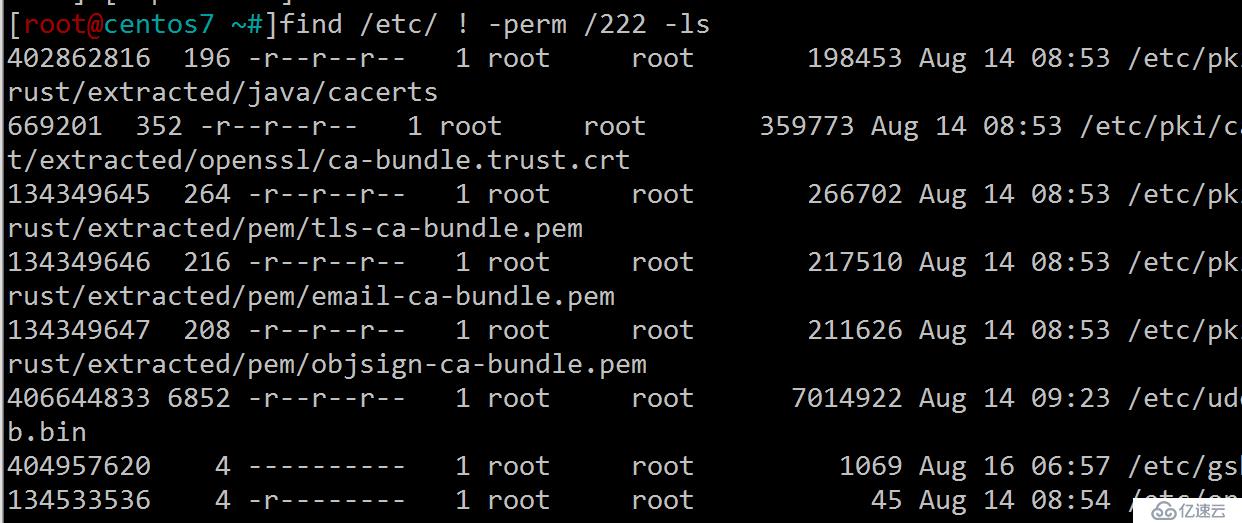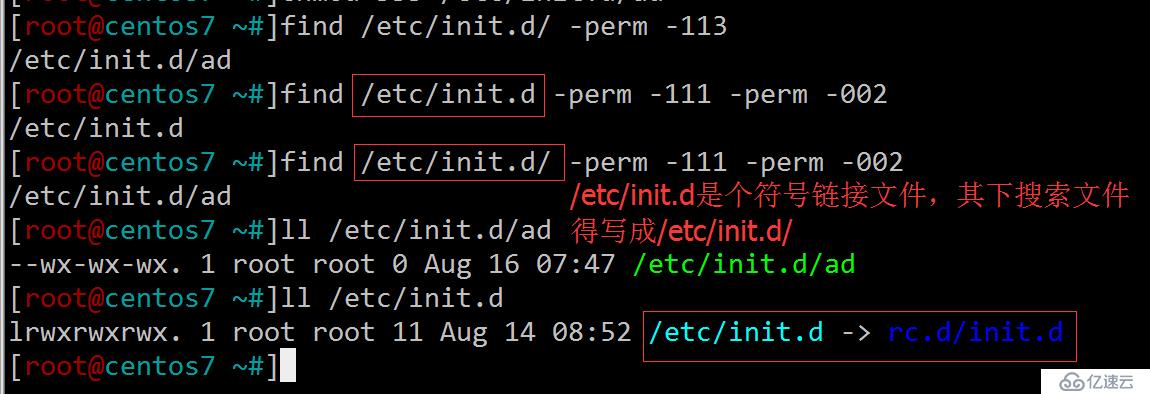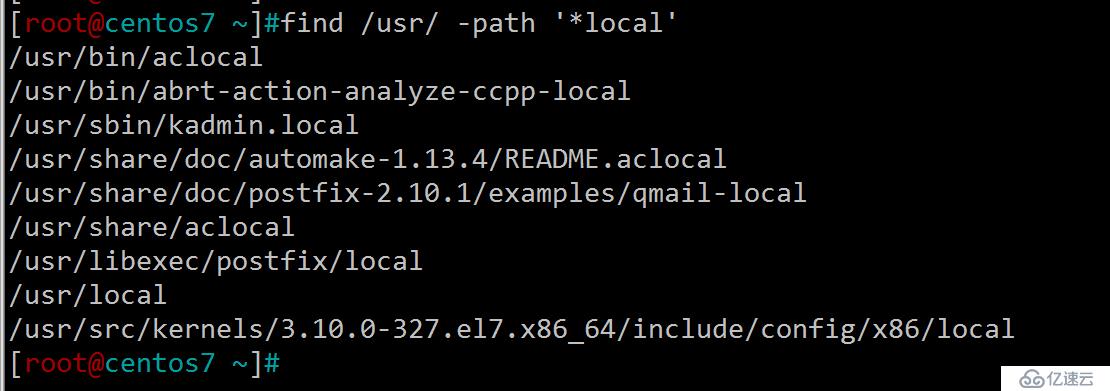locate
find
压缩与归档
locate
主要用途
查询系统上预建的文件索引数据库
locate - find files by namelocate [OPTION]... PATTERN...
locate查询文件时,会去搜索/var/lib/mlocate/mlocage.db, 这个数据库会在系统空闲时自动周期性进行,一般一天一次更新,手动更新命令为updatedb, 索引的构建需要遍历整个根文件系统,比较消耗资源。但locate有如下特性:
1. 模糊查找,速度快 2. 非实时查找,搜索的是文件的全路径,而非文件名 3. 可能只搜索用户具有读取与执行权限的目录
常用参数
-d: --database, 指定数据库所在的目录
-i: --ignore-case, 搜索时忽略大小写
-n N: 只列举前N个匹配项目
-r: --regexp, 搜索时支持正则表达式
使用示例
查找/etc/目录下以sh开头的文件:
[root@centos7 ~#]locate /etc/sh /etc/shadow /etc/shadow- /etc/shells [root@centos7 ~#]locate -r "/etc/\<sh" # 正则,锚定词首 /etc/shadow /etc/shadow- /etc/shells [root@centos7 ~#]
更新数据库
[root@centos7 ~#]locate ~/a /root/anaconda-ks.cfg [root@centos7 ~#]updatedb [root@centos7 ~#]locate ~/a /root/a.sh /root/anaconda-ks.cfg [root@centos7 ~#]
忽略字符大小写
[root@centos7 ~#]locate -i ~/d /root/Desktop/root/Documents/root/Downloads /root/d1 /root/dd /var/lib/pcp/pmdas/root/domain.h [root@centos7 ~#]
find
主要用途
实时查找文件
find - search for files in a directory hierarchy find [-H] [-L] [-P] [-D debugopts] [-Olevel] [path...] [expression]
find命令是一个实时查找工具,通过遍历指定路径而完成对文件的查找;在使用该命令时,如果不选定参数,则在当前目录下查找子目录与文件并显示之;另外,任何位于参数之前的字符串,都将视为欲查找的目录名。由于是实时遍历查找,find有如下特性:
精确实时查找,速度慢 可能只搜索用户具备读取和执行权限的目录
find语法:
find [OPTION]... [查找路径] [查找条件] [处理动作]查找路径:指定具体目标路径,默认为当前目录 查找条件:指定的查找标准,可以是文件名、大小、类型、权限等标准进行;默认为找出指定路径下的所有文件 处理动作:对符合条件的文件做操作,默认输出至屏幕
查找条件
1. 根据文件名和inode查找 2. 根据属主、属组查找 3. 根据文件类型查找 4. 根据逻辑组合条件查找 5. 根据文件大小来查找 6. 根据时间戳来查找 7. 根据权限来查找
处理动作
1. -print: 默认动作,显示至屏幕
2. -ls: 类似于对查找到的文件执行 ls -l 命令
3. -delete: 删除查找到的文件
4. -fls file: 查找到的所有长格式的信息保存至指定文件中
5. -ok COMMMAND {} \; 对查找到的每个文件执行由COMMAND指定的命令,且都会交互式要求用户确认
6. -exec COMMAND {} \; 对查找到的每个文件执行由COMMAND指定的命令;
7. {}: 用于引用查找至的文件名称自身
8. find 传递查找到的文件至后面指定的命令时,查找到所有符号条件的文件一次性传递给后面的命令
9. 有些命令不能接受过多的参数,此时命令执行可能会失败,用 xargs 来规避此问题
find |xargs COMMAND常用参数
文件名和inode类:
-name "文件名称": 支持使用glob, *, ?, [], [^]
-iname "文件名称": 不区分字母大小写
-inum n: 按inode号查找
-somefile name: 相同的inode号文件
-links n: 链接数为n的文件
-regex "PATTERN": 以PATTERN匹配整个文件路径字符串,而不仅仅是文件名称
属主属组类:
-user USERNAME: 查找属主为指定用户(UID)的文件
-group GROUPNAME: 查找属组为指定组(GID)的文件
-uid UserID: 查找属主为指定的UID号的文件
-gid GroupID: 查找属组为指定的GID号的文件
-nouser: 查找没有属主的文件
-nogroup: 查找没有属组的文件
文件类型类:
b block (buffered) special c character (unbuffered) special d directory p named pipe (FIFO)f regular file l symbolic link s socket
逻辑组合条件类:
组合条件: 与:-a 或:-o 非:-not, ! 摩根定律: (非P) 或(非Q) = 非(P且Q) (非P) 且 (非Q) = 非(P或Q) 示例: !A -o !B = !(A -a B) !A -a !B = !(A -o B)
文件大小类:
-size [+|-]#UNIT 常用单位:k,M,G #UNIT: (#-1,#] 如:5M 表示 (4M,5M] -#UNIT: [0,#-1] 如:-5M 表示 [0,5M] +#UNIT: (#,oo) 如:+5M 表示 (6M,oo)
关于文件大小类的解释:为什么-size 5M 还是找精确的5M而是表示(4M,5M], 试想文件的大小指什么?是指文件数据的大小还是包括了元数据后的大小,那你找元数据的大小有意义吗?但文件的大小肯定是包含元数据大小的,而我们一般以文件大小找文件时往往考虑的是文件数据的大小;另外,精确查找一定大小的文件意义不大;所以这里的大小会有1个单位的浮动。
时间戳类:
以”天”为单位: -atime [+|-]# #: [#,#+1) +#: [#+1,oo) -#: [0,#) -mtime -ctime 以“分钟”为单位: -amin -mmin -cmin
关于时间戳类的解释:为什么-atime 3 表示的是 [3,4),这个就很好解释了,我们这儿所说的时间是指时间段而非时刻,一“天”与一“分钟”都是指一个时间段,只有[3,4)这个半闭半开的区间才能完整地表示第三天。
权限类:
-perm [/|-]MODE MODE: 精确匹配权限 /MODE: 任何一类(u,g,o)对象的权限中只要能一位匹配即可,属于或关系。以前用'+',CentOS 7以'/'替代之 -MODE: 每一类对象都必须同时拥有指定权限,属于与关系 0:表示不关注 示例: find -perm 644 表示要严格匹配644的文件 find -perm +222 表示u,g,o任何一类用户有写权限即匹配 find -perm -222 表示仅严格匹配写权限,即每个用户必须要有写权限 find -perm -002 表示仅严格匹配other用户的写权限
使用示例
1.将配置文件备份到指定目录下并添加扩展名.org
[root@centos7 ~#]find -name "*.conf" -exec cp -r {} /testdir/{}.org \;
2.提示删除存在时间超过3天以上的liansir的临时文件
[root@centos7 ~#]find /tmp -ctime +3 -user liansir -ok rm {} \;3.在主目录中查找可被其它用户写入的文件
[root@centos7 ~#]find ~ -perm -002 -exec chmod o-w {} \;4.查找/var目录下属主为root,且属组为mail的所有文件
[root@centos7 ~#]find /var/ -user root -group mail -ls 402656342 4 drwxrwxr-x 2 root mail 4096 Aug 15 22:56 /var/spool/mail 407540491 4 -rw------- 1 root mail 2878 Aug 14 00:25 /var/spool/mail/root [root@centos7 ~#]
5.查找/var目录下不属于root、lp、gdm的所有文件
[root@centos7 ~#]find /var/ ! -user root ! -user lp ! -user gdm
6.查找/var目录下最近一周内其内容修改过,同时属主不为root,也不是postfix的文件
[root@centos7 ~#]find /var/ -ctime -7 ! -user root ! -user postfix
7.查找当前系统上没有属主或属组,且最近一个周内曾被访问过的文件
[root@centos7 ~#]find / -nouser -nogroup -atime -7 | wc -l find: ‘/proc/7562/task/7562/fd/6’: No such file or directory find: ‘/proc/7562/task/7562/fdinfo/6’: No such file or directory find: ‘/proc/7562/fd/6’: No such file or directory find: ‘/proc/7562/fdinfo/6’: No such file or directory 15 [root@centos7 ~#]
8.查找/etc目录下大于1M且类型为普通文件的所有文件
[root@centos7 ~#]find /etc/ -type f -size +1M /etc/udev/hwdb.bin /etc/selinux/targeted/policy/policy.29 /etc/brltty/zh-tw.ctb [root@centos7 ~#]
9.查找/etc目录下所有用户都没有写权限的文件
[root@centos7 ~#]find /etc/ ! -perm /222

10.查找/etc目录下至少有一类用户没有执行权限的文件
[root@centos7 ~#]find /etc/ ! -perm -111 # 至少有一类用户没用就是所有用户都没有

11.查找/etc/init.d目录下,所有用户都有执行权限,且其它用户有写权限的文件
[root@centos7 ~#]find /etc/init.d/ -perm -113 或 [root@centos7 ~#]find /etc/init.d/ -perm -111 -perm -002

12.摩根定律
找出/tmp目录下,属主不是root,且文件名不以f开头的文件
[root@centos7 ~]#find /tmp \( -not -user root -a -not -name 'f*' \) -ls 即 [root@centos7 ~]#find /tmp -not \( -user root -o -name 'f*' \) -ls

13.排除目录
查找/etc/下,除/etc/sane.d目录的其它所有.conf后缀的文件
[root@centos7 ~]#find /etc -path '/etc/sane.d' -prune -o -name '*.conf'

14.匹配文件路径或文件
[root@centos7 ~]#find /usr/ -path '*local'

15.基于正则表达式匹配文件路径
[root@centos7 ~]#find . -regex "\(.*\.txt | \.cfg\)$"
压缩与归档
数据压缩,就是在不丢失数据信息的前提下减少数据量的一种技术。
compress
compress是一个古老的压缩工具,其压缩文件后缀为.Z,zcat命令可查看.Z的文件,但并不解压。
-d: 解压缩-c: 结果输出至标准输出,不删除原文件-v: 显示详情
使用示例
[root@centos7 /testdir]#compress passwd # 压缩 [root@centos7 /testdir]#ls passwd.Z [root@centos7 /testdir]#compress -d passwd # 解压 [root@centos7 /testdir]#ls passwd [root@centos7 /testdir]# [root@centos7 /testdir]#zcat passwd.Z > passwd [root@centos7 /testdir]#lspasswd passwd.Z [root@centos7 /testdir]#
gzip
gzip压缩后的文件后缀为.gz,如果压缩的是tar备份文件,则扩展名为.tar.gz
gzip, gunzip, zcat - compress or expand files -d: 解压缩,相当于unzip -c: 将压缩或解压缩的结果输出至标准输出 -#:1-9,指定压缩比zcat: 不显示解压缩的前提下查看文本文件内容
使用示例
[root@centos7 /testdir]#gzip passwd [root@centos7 /testdir]#ls passwd.gz passwd.Z [root@centos7 /testdir]# [root@centos7 /testdir]#zcat passwd.gz > passwd [root@centos7 /testdir]#ls passwd.gz passwd passwd.Z [root@centos7 /testdir]#
bzip2
bzipw2压缩的文件的扩展名为.bz2
-k: keep,保留原文件 -d: 解压缩 -#:1-9,压缩比,默认为6bzcat: 不显示解压缩的前提下查看文件文件内容
使用示例
[root@centos7 /testdir]#bzip2 passwd [root@centos7 /testdir]#ls passwd.gz passwd.bz2 passwd.Z[ root@centos7 /testdir]#bzcat passwd.bz2 > passwd [root@centos7 /testdir]#ls passwd.gz passwd passwd.bz2 passwd.Z [root@centos7 /testdir]#
xz
xz压缩后的文件扩展名为.xz
-k: keep,保留原文件 -d: 解压缩 -#:1-9,压缩比,默认为6xzcat: 不显示解压缩的前提下查看文件文件内容
[root@centos7 /testdir]#xz passwd [root@centos7 /testdir]#ls passwd.bz2 passwd.gz passwd.xz passwd.Z [root@centos7 /testdir]# [root@centos7 /testdir]#xzcat passwd.xz > passwd [root@centos7 /testdir]#ls passwd passwd.bz2 passwd.gz passwd.xz passwd.Z [root@centos7 /testdir]#
zip: 打包压缩
文件经zip压缩后会另外生成.zip的文件而不删除原文件。
zip - package and compress (archive) files -r: 递归处理,将指定目录下的所有文件与子目录一并处理 -q: 不显示执行过程
使用示例
[root@centos7 /testdir]#zip -q passwd ./passwd [root@centos7 /testdir]#ls passwd passwd.bz2 passwd.gz passwd.xz passwd.Z passwd.zip [root@centos7 /testdir]#
看看大概的压缩情况:
[root@centos7 /testdir]#ll total 192 -rw-r--r--. 1 root root 164065 Aug 19 09:06 message.zip -rw-r--r--. 1 root root 4129 Aug 19 08:46 passwd -rw-r--r--. 1 root root 1526 Aug 19 08:30 passwd.bz2 -rw-r--r--. 1 root root 1539 Aug 19 08:39 passwd.gz -rw-r--r--. 1 root root 1540 Aug 19 08:45 passwd.xz -rw-r--r--. 1 root root 2151 Aug 19 08:16 passwd.Z -rw-r--r--. 1 root root 1676 Aug 19 09:02 passwd.zip [root@centos7 /testdir]#
tar
tar [OPTION...] [FILE]... EXAMPLES tar -cf archive.tar foo bar # Create archive.tar from files foo and bar. tar -tvf archive.tar # List all files in archive.tar verbosely. tar -xf archive.tar # Extract all files from archive.tar.
tar命令可为文件或目录创建档案(备份文件),tar命令可将很多文件打包成一个文件,从而可结合压缩工具实现归档并压缩了。
常用参数
-c: --creat, 创建新的备份文件
-f: --file=ARCHIVE, 指定备份文件
-x: --extract, --get, 从备份文件中还原文件
-t: --list, 列出备份文件的内容
-v: --verbose
tar用法小结:
(1) 创建归档 tar -c -f /PATH/TO/SOMEFILE.tar FILE... tar cf/PATH/TO/SOMEFILE.tar FILE... (2) 查看归档文件中的文件列表 tar -t -f /PATH/TO/SOMEFILE.tar(3) 展开归档 tar -x -f /PATH/TO/SOMEFILE.tar tar -x -f /PATH/TO/SOMEFILE.tar -C /PATH/ (4) 结合压缩工具实现:归档并压缩 -j: bzip2, -z: gzip, -J: xz 打包成tar包: tar -cvf passwd.tar passwd 仅打包,不压缩 tar -zcvf passwd.tar.gz passwd 打包并以gzip压缩 tar -jcvf passwd.tar.bz2 passwd 打包并以bzip2压缩 tar -Jcvf passwd.tar.xz passwd 打包并以xz压缩
使用示例
[root@centos7 /testdir]#tar -cf passwd.tar passwd [root@centos7 /testdir]#ls passwd passwd.tar [root @centos7 /testdir]#tar -zcf passwd.tar.gz passwd [root@centos7 /testdir]#ls passwd passwd.tar passwd.tar.gz [root@centos7 /testdir]#tar -jcf passwd.tar.bz2 passwd [root@centos7 /testdir]#ls passwd passwd.tar passwd.tar.bz2 passwd.tar.gz [root@centos7 /testdir]#tar -Jcf passwd.tar.xz passwd [root@centos7 /testdir]#ls passwd passwd.tar passwd.tar.bz2 passwd.tar.gz passwd.tar.xz [root@centos7 /testdir]# [root@centos7 /testdir]#tar -tvf passwd.tar # 查询 -rw-r--r-- root/root 10240 2016-08-19 09:27 passwd [root@centos7 /testdir]#tar -tvf passwd.tar.gz -rw-r--r-- root/root 10240 2016-08-19 09:27 passwd [root@centos7 /testdir]# [root@centos7 /testdir]#tar xf passwd.tar # 解压 [root@centos7 /testdir]#ls passwd passwd.tar passwd.tar.bz2 passwd.tar.gz passwd.tar.xz [root@centos7 /testdir]#tar xf passwd.tar.gz [root@centos7 /testdir]#ls passwd passwd.tar passwd.tar.bz2 passwd.tar.gz passwd.tar.xz [root@centos7 /testdir]# [root@centos7 /testdir]#ll total 44 -rw-r--r--. 1 root root 10240 Aug 19 09:27 passwd -rw-r--r--. 1 root root 20480 Aug 19 10:52 passwd.tar -rw-r--r--. 1 root root 116 Aug 19 10:53 passwd.tar.bz2 -rw-r--r--. 1 root root 120 Aug 19 10:52 passwd.tar.gz -rw-r--r--. 1 root root 180 Aug 19 10:53 passwd.tar.xz
cpio
cpio命令是通过重定向的方式将文件进行打包备份,还原恢复的工具,它可以解压以.cpio或者.tar结尾的文件;换言之,cpio可以复制文件到归档包中,或者从归档包中复制文件。
cpio - copy files to and from archives cpio[选项] > 文件名或者设备名 cpio[选项] < 文件名或者设备名 EXAMPLES % ls | cpio -ov > directory.cpio % find . -print -depth | cpio -ov > tree.cpio % cpio -iv < directory.cpio % cpio -idv < tree.cpio % find . -depth -print0 | cpio --null -pvd new-dir
常用参数
-o: --create,Run in copy-out mode,将文件拷贝打包成文件或者将文件输出到设备上
-i: --extract,Run in copy-in mode,解包,将打包文件解压或将设备上的备份还原到系统
-t: 预览,查看文件内容或者输出到设备上的文件内容
-v: 显示打包过程中的文件名称。
-d: 解包生成目录,在cpio还原时,自动的建立目录
-c: 一种较新的存储方式
使用示例
[root@centos7 /]#find ./etc |cpio -o > etc.cpio # 备份/etc目录

[root@centos7 /testdir]#find /etc/issue |cpio -o >issue.cpio1 block [root@centos7 /testdir]#lsissue.cpio [root@centos7 /testdir]#cpio -tv <issue.cpio # 显示预览 -rw-r--r-- 1 root root 23 Dec 9 2015 /etc/issue1 block [root@centos7 /testdir]#
cpio在打包备份时用的是绝对路径,且cpio无法直接读取文件,它需要每个文件或目录的完整路径名才能读取识别,故cpio命令一般与find配合使用。
本文主要讲解了文件查找与压缩,文件查找命令主要有locate与find; 常见的压缩工具有gzip, bzip2, xz, zip还有tar这个打包压缩归档命令。
止战
2016.8.19
免责声明:本站发布的内容(图片、视频和文字)以原创、转载和分享为主,文章观点不代表本网站立场,如果涉及侵权请联系站长邮箱:is@yisu.com进行举报,并提供相关证据,一经查实,将立刻删除涉嫌侵权内容。